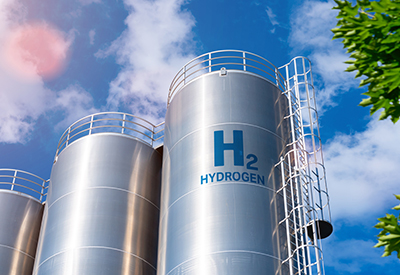Hydrogen is less dense than air and is insoluble in water. In fact, it has the lowest density compared to other gasses. Owing to its dual nature, it has a wide range of uses across various industries, including energy, manufacturing, and research. This article delves into hydrogen gas uses, covering its production, applications, and environmental impact.
How Is Hydrogen Produced?
Despite hydrogen being one of the most abundant elements on earth, it mostly exists as part of other compounds such as methane (CH₄) and water (H₂O). As a result, it must undergo various processes to separate it into its pure form (H₂) for use in different applications. There are several methods to produce hydrogen energy, as explained below:
Steam-Methane Reforming
Almost all commercially produced hydrogen in the United States is generated via steam-methane reforming. Steam reforming involves using steam (700°C to 1000°C) to heat methane, often with a catalyst, to generate a mixture of hydrogen, carbon (II) oxide, and a small amount of carbon (IV) oxide. Afterward, the steam reacts with the carbon monoxide in the presence of a catalyst to generate carbon (IV) oxide and more hydrogen gas. This process is called the water-gas shift reaction.
The last step is known as the pressure-swing adsorption process. Here, carbon (IV) oxide and additional impurities are eliminated from the gas stream, leaving hydrogen in its purest form. The steam reforming can also produce hydrogen from alternative fuel sources, such as gasoline and propane.
Electrolysis
Electrolysis entails separating hydrogen from water using an electric current. The produced hydrogen will also be classified as renewable if the power is generated from renewable sources. The process occurs in an electrolyzer, with carbon and oxygen as the by-products.
Additional Methods Of Hydrogen Production
Research is ongoing to introduce other methods of hydrogen production, such as:
- The photolytic process that leverages the sun's energy to break water into hydrogen and oxygen molecules.
- Biological processes that use bacterial reactions to generate hydrogen.
- Biomass-derived liquid reforming.
Clean hydrogen/ green hydrogen is generated from renewable energy sources without emissions. The electricity from renewable sources breaks down water into hydrogen and oxygen molecules during electrolysis. The hydrogen roadmap identifies opportunities for clean hydrogen production between different industries and federal government agencies.
Hydrogen Uses
Hydrogen gas is used widely across different sectors, including industrial, energy, food and manufacturing, medical, and aerospace. The following are the top hydrogen applications:
Industrial Applications
Hydrogen is used in many different industrial processes because of its unique properties. The following are some of the top hydrogen uses for industrial applications:
Ammonia Production
Ammonia production is largely dependent on the availability of hydrogen gas. The Haber-Bosch process entails the synthesis of hydrogen and nitrogen under high temperature and pressure and with the help of a metal catalyst to generate ammonia (NH₃). Ammonia is mostly used to produce fertilizers, as a base for many cleaning materials, and as a refrigerant.
Use In Petroleum Refining
The two primary applications of hydrogen in the petroleum refining industry include:
- Hydrocracking is a process that entails breaking down complex hydrocarbons like oil into lighter molecules such as jet fuel and gasoline.
- Hydrotreating is the process of creating cleaner and more efficient hydrocarbon streams by removing impurities like metals and sulfur.
- Desulfurization involves using hydrogen to remove sulfur from crude oil during refining.
Energy Sector
Hydrogen fuel cells are a vital technology in the shift to clean energy. Through an electrochemical reaction between hydrogen and oxygen, hydrogen fuel cells act as an alternative fuel that can power motor vehicles. These fuel cell electric vehicles (FCEVs) are highly efficient and have a longer range. Also, when used in a fuel cell to generate electricity, hydrogen produces no harmful tailpipe emissions.
Hydrogen-powered vehicles are vital to the future hydrogen clean energy generation ecosystem. With advancing technology and infrastructure development, these vehicles are expected to play a more significant role in lowering the global carbon footprint.
Medical Uses
Thanks to its therapeutic properties, hydrogen is used widely in the medical field. For example, it can be used as a therapeutic gas because of its antioxidant and anti-inflammatory attributes for conditions such as respiratory problems, cardiovascular health, and neuroprotection from health issues such as Parkinson's and Alzheimer's disease.
Moreover, taking hydrogen-rich water is believed to have numerous therapeutic advantages thanks to its antioxidant benefits. Drinking this water improves metabolic health, provides anti-aging advantages, helps reduce fatigue, and improves recovery in athletes.
Food Industry
Hydrogen gas is widely used in the food industries in various processes such as:
- Hydrogenation of unsaturated fats and oils to turn them into saturated fats.
- Hydrogen peroxide works as a sterilizing and preservative agent.

Emerging Uses Of Hydrogen Gas
Hydrogen gas has immense potential to play a transformative role as the main sustainable and clean energy source. Here is a deeper look at innovative and future uses:
The Hydrogen Economy
The primary objective of the hydrogen economy is to significantly lower emissions in situations where affordable and more energy-efficient clean solutions are not possible. It envisions a world where hydrogen is the primary carbon-free energy carrier, replacing fossil fuels. This shift is propelled by the need to reduce the global carbon emissions and achieve the sustainability goals.
Renewable Energy Storage
Hydrogen can be used to store surplus energy generated from renewable energy sources such as wind. It offers a viable solution for storing extra energy produced during peak production hours, which can be converted to hydrogen via electrolysis and stored for use during low production hours.
Advanced Technologies
Hydrogen plays a significant role in cutting-edge technologies and research. Here are worthwhile mentions:
- Current research is focused on improving the efficiency and durability of hydrogen fuel cells, allowing them to be used as backup power for data centers and for portable power generation.
- Research is ongoing in the aviation industry to design fuel cells and combustion systems for commercial aircraft to reduce the carbon footprint of air travel.
- Thanks to hydrogen's high energy density, NASA is extensively researching the use of hydrogen fuel cells to power spacecraft.
Environmental Impact Of Hydrogen Gas
With the rising demand for sustainable energy sources, hydrogen continues to increase in popularity, especially in the heavy-duty mobility sector. Here are the pros and cons of this promising green technology:
Advantages Of Hydrogen As A Clean Energy Source
- Zero-emissions. Hydrogen is a cleaner substitute for fossil fuels because it does not generate greenhouse gases when used as an energy source.
- Due to its high energy content per unit mass, hydrogen is an efficient energy carrier.
- Hydrogen generated via electrolysis using renewable energy sources such as wind can help lower global carbon emissions.
Disadvantages Of Hydrogen As A Clean Energy Source
- Currently, approximately 95% of all hydrogen is generated from fossil fuels. This means that to produce 74 million tonnes of hydrogen in a year, we emit an average of 830 million tonnes of carbon (IV) Oxide.
- Producing hydrogen, especially from renewable energy sources, can be costly.
- Due to its low energy density by volume, hydrogen requires unique infrastructure and technologies for transportation.
- Hydrogen is a highly flammable gas, requiring advanced safety measures for use, storage, and transportation.
Hydrogen gas has many important applications, from being a base ingredient in industrial processes to playing a transformational role in science and technology. However, the challenges associated with safety, environmental pollution, production costs, and infrastructure development must be resolved to reach hydrogen's full potential.
To support this transition to clean energy, DILO provides various innovative products for hydrogen applications, such as helium leak testing units and high-pressure tube unions. Contact us today with follow-up questions and additional information.





